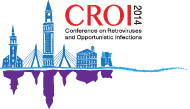Dual therapy less effective at high viral load: NEAT 001 study with raltegravir/darunavir/r
24 March 2014. Related: Conference reports, Antiretrovirals, Treatment strategies, CROI 21 (Retrovirus) 2014.
Simon Collins, HIV i-Base
 An experimental dual therapy combination of an integrase inhibitor plus a boosted-PI was non-inferior at week 96 compared to PI-based triple therapy, but was less effective in patients starting with a high viral load.
An experimental dual therapy combination of an integrase inhibitor plus a boosted-PI was non-inferior at week 96 compared to PI-based triple therapy, but was less effective in patients starting with a high viral load.
Francois Raffi, from University Hospital, Nantes, presented results from a European independent investigator collaboration comparing twice-daily raltegravir (n=401) to once-daily tenofovir/FTC (n=404) in combination with once-daily darunavir/ritonavir (800 mg/100 mg) in treatment-naive patients.
This was the NEAT001 study (ANRS143 in France), and the first from a EU network of independent investigators, with 78 sites in 15 countries. NEAT001 is a randomised, phase 3, open-label, 96 week study with a composite primary endpoint of time to virological or clinical failure. It is a non-inferiority study with an absolute difference of 9% defined for failure of raltegravir by ITT analysis. Entry criteria included CD4 count <500 cells/mm3, hepatitis B negative and having no major drug resistance mutations.
Virological failure was defined as <1 log reduction by week 18 or viral load >400 copies/mL at week 24, or if viral load was >50 copies/mL at or after week 32. Clinical endpoints included any new or recurrent serious event.
Participants were largely male (88%) and white (82%) with median age 37 years. At baseline, median viral load was 4.8 (IQR 4.2, 5.1) log copies/mL with 36% vs 32% having >100.000 in the raltegravir vs tenofovir/FTC arms respectively (and 6% vs 5% with >500,000). Median CD4 count was 340 (IQR 260, 394) vs 325 (IQR 248, 401) respectively with approximately 15% having a count <200 cells/mm3.
There were more discontinuations prior to week 96 in the raltegravir arm (n=38 vs 22), mainly driven by greater loss to follow-up (n=24 vs 15), although there were also more deaths (n=4 vs 0) compared to the tenofovir/FTC arm. Although numerically the raltegravir arm had a greater probability of reaching the primary endpoint at week 96, with 17.4% vs 13.7% having treatment failure, this supported a non-inferiority result with an adjusted between-arm difference of 3.7% (95% CI: -1.1 to 8.6%), p=0.12).
This difference was driven by more patients having viral load >50 copies/mL after week 32 (n=32 vs 22). At week 96, 89% vs 93% patients had viral load <50 copies/mL in the raltegravir and darunavir/r arms respectively. Serious AIDS-related events occurred in 5 vs 3 people and serious non-AIDS event occurred in 7 people in each arm.
In a planned stratified analysis, raltegravir was inferior in more advanced patients. Primary endpoint results at week 96 when baseline CD4 count was <200 cells/mm3 were 39.0% vs 21.3%, p=0.02 with a trend to non-inferiority when baseline viral load was >100,000 copies/mL (36% vs 27%; p=0.09).
No resistance was detected in 13/15 patients with virological failure and genotypic results in the tenofovir/FTC arm compared to five major mutations in 28/36 patient with results with raltegravir. This included one case of K65R and five patients with N155H. In questions after the presentation, 4/5 of these patients were said to have had baseline viral load “considerably higher than 500,000 copies/mL”.
The differences in serious side effects were numerically higher in the raltegravir arm, but differences were not statistically significant. There were 89 vs 75 events (in 73 vs 61 patients; incidence rate 10.2 vs 8.3/100 PY, p=0.17).
The four deaths in the raltegravir arm were from Burkitt’s lymphoma, DRESS syndrome, melanoma and suicide, with the single death in the tenofovir/FTC arm from morphine overdose. Life threatening events occurred in 8 vs 4 patients (CK increase (n = 5), hepatitis, Hodgkin lymphoma, pancreatitis vs CK increase (n = 2), myocardial infarction and gGT increase).
Changes in fasting lipids were more significant in the raltegravir group (TC p<0.001, LDL-c p=0.02, HDL-c p<0.001 and TG p=0.49) but there were no significant different in TC:HDL-c ratio (p=0.7). Grade 3/4 creatinine kinase elevation occurred in 6.2% vs 5.0% and grade 3/4 ALT increase in 3.0 vs 1.0% of the raltegravir vs tenofovir/FTC arms respectively.
Creatinine clearance measured by eGFR at week 96 increased by 0.9 in the raltegravir group compared to dropping by -3.8 in the tenofovir/FTC arm (p=0.02) with the drop occurring in the first four weeks of treatment.
Reference
Raffi F et al. First-line raltegravir (RAL) + darunavir/ritonavir (DRV/r) is non-inferior to tenofovir/emtricitabine (TDF/FTC) + DRV/r: the NEAT 001/ANRS 143 randomised trial. 21st CROI, 3–6 March 2014, Boston. Late breaker oral abstract 84 LB.
http://www.croiwebcasts.org/console/player/22164

